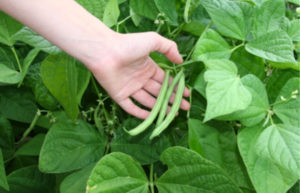Green Beans are a Favorite Vegetable

Green Beans are among America’s Favorite Vegetables in the Home Garden.
Green beans are a class of beans grown specifically to be eaten while still unripe and are called string beans, green beans, snap beans, or pole beans. String beans have over the years been cultivated so that they will be “stringless,” that is, so they do not have the fibrous inedible string along the pod seam.
‘Blue Lake Bush’ beans are prolific plants that feature 5- to 6-inch-long, straight, stringless snap beans on 24-inch-tall bushy vines. This heirloom green bean, like other bush and pole beans, is an easy-to-grow annual, thriving in your garden over a single growing season.
These beans are found in two major groups, bush beans and pole beans. Bush beans are short plants, growing to approximately two feet in height, without requiring supports. They generally reach maturity and produce all of their fruit in a short time, then cease to produce.
In home gardens, green beans are, in fact, the third most commonly grown garden vegetable in the United States, outranked only by tomatoes and peppers. They thrive in nearly every section of the country, permit soils that range from clay to sandy, and produce an ample crop in around 45 days.
Bean Seeds (Bush) – Slenderette, Vegetable…
Grow Heirloom Beans – Plant Slenderette Bean SeedsEuropean chefs agree that Slenderette… [More]
Prepare the Garden
Remove any plant debris, weeds, sticks and rocks from a sunny garden bed. Add 2 to 4 inches of compost and dig it in to a depth of 8 to 10 inches. Rake the soil smooth, and then into raised 18-inch wide rows set 18 to 24 inches apart. Water before planting the seeds.
Alternately, fill containers with potting soil or a mixture of compost, coconut coir and coarse sand. Containers should be at least 8 inches wide and equally tall.
Avoid adding nitrogen fertilizers to the soil, which will encourage foliage, but not flowers and pods. Beans fix nitrogen in the soil; no additional nitrogen is needed.
Planting the Seeds
Two weeks after the last frost, plant a double row of bean seeds in the raised soil. Set the two rows approximately 8 inches apart, with the seeds 1 to 1 1/2 inches deep and 3 to 4 inches apart. Keep the soil evenly moist while the seeds germinate, in four to 10 days. Snip the excess seedlings with scissors, so the strongest are 4 to 6 inches apart. Be sure to dip the scissors into Lysol or Pine-Sol to prevent the spread of disease.
While the bush beans will support each other as they grow, add a 24- to 36-inch-tall trellis between the two rows at planting time for additional support. To ensure a continuous harvest, plant additional rows of beans every two weeks.
Because beans are members of the legume family of plants, they can benefit from an application of a soil inoculant designed for beans and peas, prior to planting. The inoculant will enable the plants to take nitrogen from the air to use as fertilizer, which can increase crop yield and quality.
Water and Feed the Bean Plants
Keep the soil evenly moist, but not waterlogged. When the soil is dry to a depth of 1 inch, water the beans. Avoid wetting the foliage; water with a soaker hose or hose-end bubbler. The plants need 1 to 1 1/2 inches of water weekly. Mulch between the raised rows to help slow the evaporation of water from the soil.
Feed beans with a balanced organic water-soluble fertilizer diluted to one-half strength when blossoms appear. Add 1 cup of compost tea per plant every seven to 10 days.
Hand-pull weeds while still small. Avoid disturbing the soil; bean plants are shallow rooted. If you damage the roots, it will affect the flowers and development of the beans.
Harvest Your Green Beans
After planting your beans, the days to harvest will be between six weeks and two months, or approximately 45 to 60 days. Because bush beans are determinate plants, most of the beans will be ready within a two-week period. Pick the beans when they are between 3 and 6 inches long while they’re still green and tender and before the pods begin bulging. Snip or snap the beans from the plants to avoid damaging the vines.
For fresh use, pick pods as soon as well-filled out with peas
For dried bean use, harvest in about 80 days, when the pods start to dry on the plant.
To Dry Beans: Allow the beans to stay on the plants until they are partially dry. Then pull up the plants and hang them in a warm, dry place with good air circulation until the pods and seeds are thoroughly dry. Shell the beans and save the pods and plants for composting.
Store freshly picked, unwashed green beans in the refrigerator for up to one week. For longer storage, wash, snap, blanch and freeze the beans for up to three months.
Monitor for Pests and Problems
Green beans suffer from a variety of problems, from insects to diseases. Avoid planting beans in the same location every year; rotate your bean patch. ‘Blue Lake’ beans with yellow leaves may indicate a nitrogen deficiency, insects or fungal infection.
Yellow and damaged or distorted leaves may indicate a sap-sucking insect infestation, such as aphids, spider mites, whiteflies or thrips. Treat severe infestations with insecticidal soaps or neem oil sprays.
Yellow leaves followed by browning or decaying leaves, stems or roots may indicate fungal diseases. Remove infected plants and put them in the trash.
